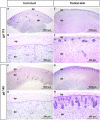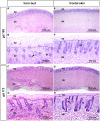Novel Features of the Prenatal Horn Bud Development in Cattle (Bos taurus)
- PMID: 25993643
- PMCID: PMC4439086
- DOI: 10.1371/journal.pone.0127691
Novel Features of the Prenatal Horn Bud Development in Cattle (Bos taurus)
Abstract
Whereas the genetic background of horn growth in cattle has been studied extensively, little is known about the morphological changes in the developing fetal horn bud. In this study we histologically analyzed the development of horn buds of bovine fetuses between ~70 and ~268 days of pregnancy and compared them with biopsies taken from the frontal skin of the same fetuses. In addition we compared the samples from the wild type (horned) fetuses with samples taken from the horn bud region of age-matched genetically hornless (polled) fetuses. In summary, the horn bud with multiple layers of vacuolated keratinocytes is histologically visible early in fetal life already at around day 70 of gestation and can be easily differentiated from the much thinner epidermis of the frontal skin. However, at the gestation day (gd) 212 the epidermis above the horn bud shows a similar morphology to the epidermis of the frontal skin and the outstanding layers of vacuolated keratinocytes have disappeared. Immature hair follicles are seen in the frontal skin at gd 115 whereas hair follicles below the horn bud are not present until gd 155. Interestingly, thick nerve bundles appear in the dermis below the horn bud at gd 115. These nerve fibers grow in size over time and are prominent shortly before birth. Prominent nerve bundles are not present in the frontal skin of wild type or in polled fetuses at any time, indicating that the horn bud is a very sensitive area. The samples from the horn bud region from polled fetuses are histologically equivalent to samples taken from the frontal skin in horned species. This is the first study that presents unique histological data on bovine prenatal horn bud differentiation at different developmental stages which creates knowledge for a better understanding of recent molecular findings.
Conflict of interest statement
Figures







References
-
- Dyce KM, Sack WC, Wensing CJG. The common integument In: Dyce KM, Sack WC, Wensing CJG, editors. Textbook of veterinary anatomy; 2002. p. 359.
-
- Reese S, Budras KD, Muelling C, Bragulla H, Koenig HE. Allgemeine Körperdecke (Integumentum Commune) In: König HE, Liebich HG, editors. Anatomie der Haussäugetiere. Schattauer; 2011. 653–655 pp.
-
- Strouhal E. Life of the Ancient Egyptians. 1st ed Liverpool University Press; 1997. 128 p.
-
- Graf B, Senn M. Behavioural and physiological responses of calves to dehorning by heat cauterization with or without local anaesthesia. Appl Anim Behav Sci. 1999; 62: 153–171.
Publication types
MeSH terms
Substances
LinkOut - more resources
Full Text Sources
Other Literature Sources
Medical

